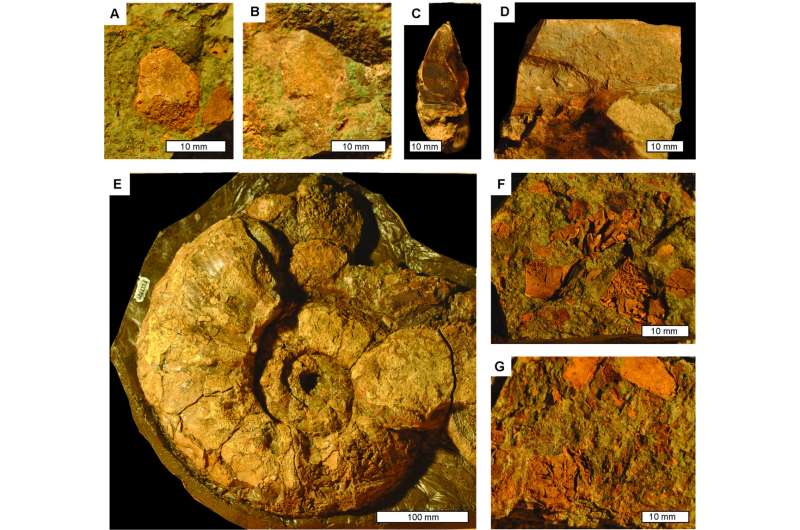Two teeth and lower mandible (cross section and side view) of pterosaur Bennettazhia oregonensis (A–D), complete ammonite Mortoniceras inflatum (E), and ammonite fragments (F, G). Specimen numbers are F127985A (A), F127910B (B), F127960 (C, D), F127929 (E), F12722D (F), F127922A (G). Credit: Lethaia (2023). DOI: 10.18261/let.56.1.3
A small team of paleontologists, assisted by a large group of volunteers has unearthed what may be evidence of an ancient colony of pterosaurs living in what is now a central region in Oregon. In their paper published in the journal Lethaia, the researchers describe a two-week dig held in the summer of 2021 at the green breccia bed in the Hudspeth Formation, located northeast of Mitchell in Oregon.
In 2018 another team of paleontologists excavated what has come to be known as the Mitchell ornithopod—a fossilized toe that once belonged to a creature living during the Cretaceous. It represented the first dinosaur fossil found in Oregon. Subsequent research suggested it was likely from an ornithopod, a type of duck-billed dinosaur.
Suspecting that more bones might be found at the same dig site, the researchers on this new effort set up a dig. Because of the small size of the team, the researchers recruited 82 volunteers, some of whom were affiliated with the North America Research Group, which is in turn affiliated with the Rice Rock and Mineral Museum in Hillsboro. Others were from the University of Oregon.
The dig involved plotting out a 6x10-meter grid and removing sand, soil and plants to give access to what the team hoped would be a bevy of dinosaur bones. Instead, the group found what they believe to be a debris flow with bits of fossilized plants and animals in it. Testing of the material in the flow showed it to be from between 100 and 113 million years ago, during the early Cretaceous. Among the debris, the team also found a thick layer of material with high levels of phosphorus.
In modern times, such levels of phosphorus are seen in places where large numbers of birds congregate. But because birds that ate mollusks had not evolved yet, the researchers suggest that it is instead indicative of a colony of pterosaurs—a clade of flying reptiles.
Bolstering their theory were the large numbers of fractured shells, including ammonites, found in the flow—evidence of the remains of creatures being cracked open and eaten by predators, likely with strong bills, such as pterosaurs.
More information: Gregory J. Retallack et al, Early Cretaceous pterosaur guano deposit from central Oregon, USA, Lethaia (2023). DOI: 10.18261/let.56.1.3
Journal information: Lethaia
© 2023 Science X Network
























